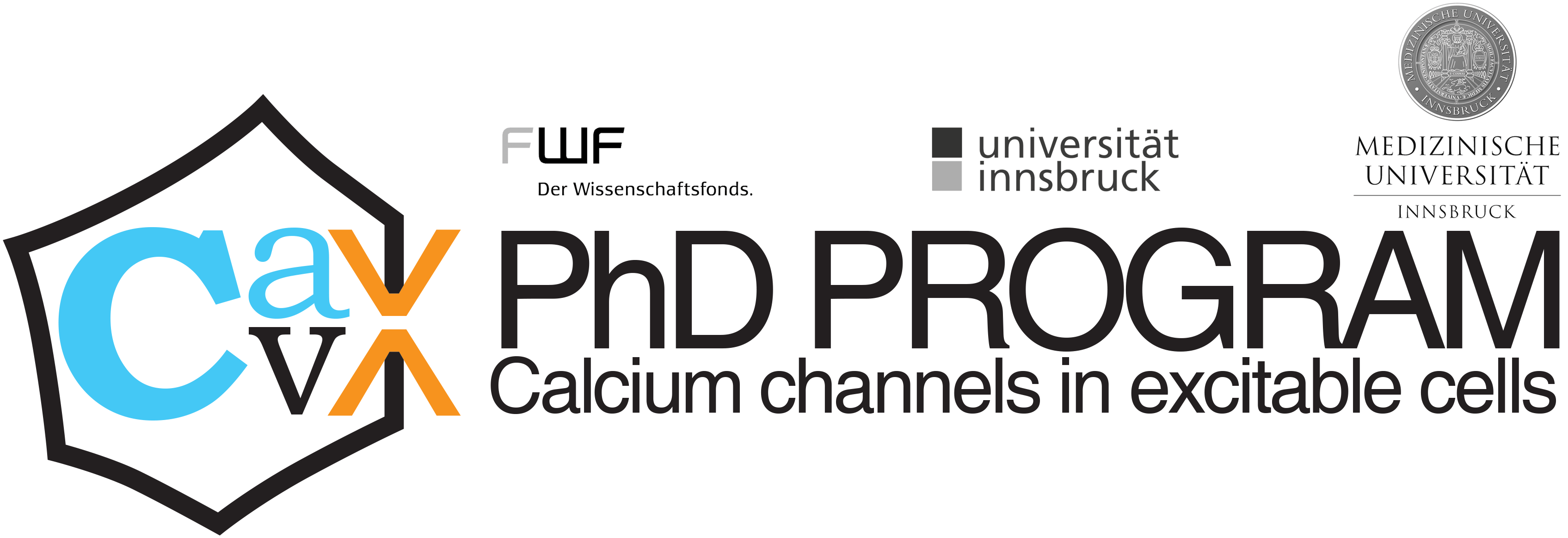// CAMPIGLIO GROUP
Keywords: excitation-contraction coupling, STAC proteins, CaV1.1 L-type calcium channels, Bailey-Bloch congenital myopathy, whole-cell patch-clamp, calcium release
// AIM
Our main interest is skeletal muscle excitation-contraction (EC) coupling, which depends on the physical interaction of the voltage sensor, the voltage-gated calcium channel CaV1.1 on the transverse tubule membrane, and the calcium release channel, the RyR1 (Ryanodine receptor 1) on the sarcoplasmic reticulum. The mechanism of this interaction is still elusive and recently an adaptor protein, STAC3, was identified as essential in this process. Our research efforts aim at advancing the understanding of the interactions established by the voltage sensor CaV1.1, the adaptor protein STAC3 and the calcium release channel RyR1 and their physiological consequences.
// APPROACH
We have implemented several approaches that could allow us to identify and characterize protein-protein interactions within the CaV1.1 complex in muscle cells. In order to test molecular interactions and to examine the functional consequences of disease variants, we generate truncated proteins, chimeras and mutated proteins and express them in a recently generated cultured muscle cell line that is genetically null for CaV1.1 and STAC3. Upon reconstitution of CaV1.1 and STAC3, the subunits localize in clusters in the triads of the muscle myotubes and restore EC coupling. High-resolution immunofluorescence microscopy is applied to study the subcellular distribution, protein-protein interactions and the assembly of functional channel complexes, while patch-clamp of calcium currents (measure of the DHPR activity) and photometric measurements of intracellular calcium (measure of the RyR1 activity) is applied to study channel function and EC coupling.
// CURRENT RESEARCH
Skeletal muscle excitation-contraction (EC) coupling is the fundamental mechanism by which an electrical signal, the action potential, is transduced into a mechanical response, muscle contraction. Recently the hitherto unnoticed scaffold protein STAC3 has been shown to be essential for this process, as it is crucial for both the stability and function of the voltage-sensor of EC coupling CaV1.1 and for voltage-induced calcium release from the sarcoplasmic reticulum (SR). Furthermore, STAC3 was shown to establish two distinct interactions with CaV1.1. However, whether a single interaction or both contribute to each function of STAC3 remains elusive. Finally, a third interaction between STAC3 and the RyR1 has been suggested, which may implicate STAC3 in the functional coupling of CaV1.1 and RyR1 in EC coupling. In our current research, we are taking advantage of a newly generated genetic muscle cell model (double CaV1.1/STAC3 KO) and a range of available and new molecular constructs (1) to dissect the functions of the multiple STAC3/CaV1.1 interactions and (2) to elucidate the contributions to skeletal muscle EC coupling of the interactions established by STAC3 in triads.
Mutations on STAC3 have also been reported to cause the Bailey-Bloch congenital myopathy (also known as Native American myopathy). Our set of tools enables us to test and analyze the effects of newly reported disease mutations on EC coupling.
// LAB MEMBERS
- Group leader: Marta Campiglio (Medical University)
- Doctoral candidates:
// ALUMNI
// ADDRESS
Division of Physiology,
Department Physiology and Medical Physics
Medical University of Innsbruck
Schöpfstrasse 41
A-6020 Innsbruck, Austria
// SELECTED PUBLICATIONS (last 5 years)
Publication of this group can be found using search term Campiglio, M[Author]
Campiglio M, Dyrda A, Tuinte WE, Török E. CaV1.1 Calcium Channel Signaling Complexes in Excitation-Contraction Coupling: Insights from Channelopathies. Handb Exp Pharmacol. 2023. Epub ahead of print. PMID: 36592225.
Yang ZF, Panwar P, McFarlane CR, Tuinte WE, Campiglio M, Van Petegem F. Structures of the junctophilin/voltage-gated calcium channel interface reveal hot spot for cardiomyopathy mutations. Proc Natl Acad Sci U S A. 2022;119(10):e2120416119. (Epub 2022 Mar 1 PMID: 35238659; PMCID: PMC8916002).
Tuinte WE, Török E, Mahlknecht I, Tuluc P, Flucher BE, Campiglio M. STAC3 determines the slow activation kinetics of CaV1.1 currents and inhibits its voltage-dependent inactivation. J Cell Physiol. 2022;237(11):4197–214.
Rufenach B, Christy D, Flucher BE, Bui JM, Gsponer J, Campiglio M, et al. Multiple Sequence Variants in STAC3 Affect Interactions with CaV1.1 and Excitation-Contraction Coupling. Structure. 2020;28(8):922-32 e5.
Coste de Bagneaux P, von Elsner L, Bierhals T, Campiglio M, Johannsen J, Obermair GJ, et al. A homozygous missense variant in CACNB4 encoding the auxiliary calcium channel beta4 subunit causes a severe neurodevelopmental disorder and impairs channel and non-channel functions. PLoS Genet. 2020;16(3):e1008625
Geisler S, Schopf CL, Stanika R, Kalb M, Campiglio M, Repetto D, et al. Presynaptic alpha2delta-2 Calcium Channel Subunits Regulate Postsynaptic GABAA Receptor Abundance and Axonal Wiring. J Neurosci. 2019;39(14):2581-605.
Flucher BE, Campiglio M. STAC proteins: The missing link in skeletal muscle EC coupling and new regulators of calcium channel function. Biochim Biophys Acta Mol Cell Res. 2019;1866(7):1101-1
El Ghaleb Y, Campiglio M, Flucher BE. Correcting the R165K substitution in the first voltage-sensor of CaV1.1 right-shifts the voltage-dependence of skeletal muscle calcium channel activation. Channels (Austin). 2019;13(1):62-71.
Coste de Bagneaux P, Campiglio M, Benedetti B, Tuluc P, Flucher BE. Role of putative voltage-sensor countercharge D4 in regulating gating properties of CaV1.2 and CaV1.3 calcium channels. Channels (Austin). 2018;12(1):249-61
Folci A, Steinberger A, Lee B, Stanika R, Scheruebel S, Campiglio M, et al. Molecular mimicking of C-terminal phosphorylation tunes the surface dynamics of CaV1.2 calcium channels in hippocampal neurons. J Biol Chem. 2018;293(3):1040-53.
Campiglio M, Coste de Bagneaux P, Ortner NJ, Tuluc P, Van Petegem F, Flucher BE. STAC proteins associate to the IQ domain of CaV1.2 and inhibit calcium-dependent inactivation. Proc Natl Acad Sci U S A. 2018;115(6):1376-81.
Campiglio M, Kaplan MM, Flucher BE. STAC3 incorporation into skeletal muscle triads occurs independent of the dihydropyridine receptor. J Cell Physiol. 2018;233(12):9045-51
Wong King Yuen SM, Campiglio M, Tung CC, Flucher BE, Van Petegem F. Structural insights into binding of STAC proteins to voltage-gated calcium channels. Proc Natl Acad Sci U S A. 2017;114(45):E9520-E8.
Campiglio M, Flucher BE. STAC3 stably interacts through its C1 domain with CaV1.1 in skeletal muscle triads. Sci Rep. 2017;7:41003.
Findeisen F, Campiglio M, Jo H, Abderemane-Ali F, Rumpf CH, Pope L, et al. Stapled Voltage-Gated Calcium Channel (CaV) alpha-Interaction Domain (AID) Peptides Act As Selective Protein-Protein Interaction Inhibitors of CaV Function. ACS Chem Neurosci. 2017;8(6):1313-26.
Rzhepetskyy Y, Lazniewska J, Proft J, Campiglio M, Flucher BE, Weiss N. A Cav3.2/Stac1 molecular complex controls T-type channel expression at the plasma membrane. Channels (Austin). 2016;10(5):346-54.
Stanika R, Campiglio M, Pinggera A, Lee A, Striessnig J, Flucher BE, et al. Splice variants of the CaV1.3 L-type calcium channel regulate dendritic spine morphology. Sci Rep. 2016;6:34528.
// FUNDING


